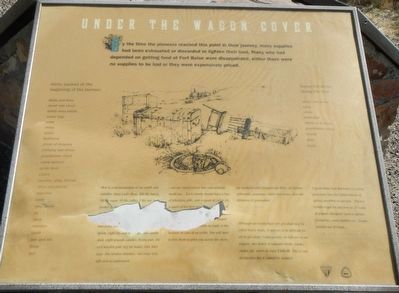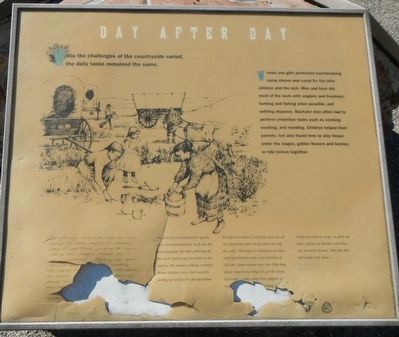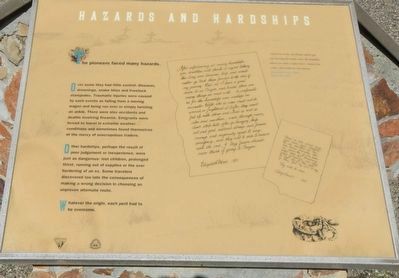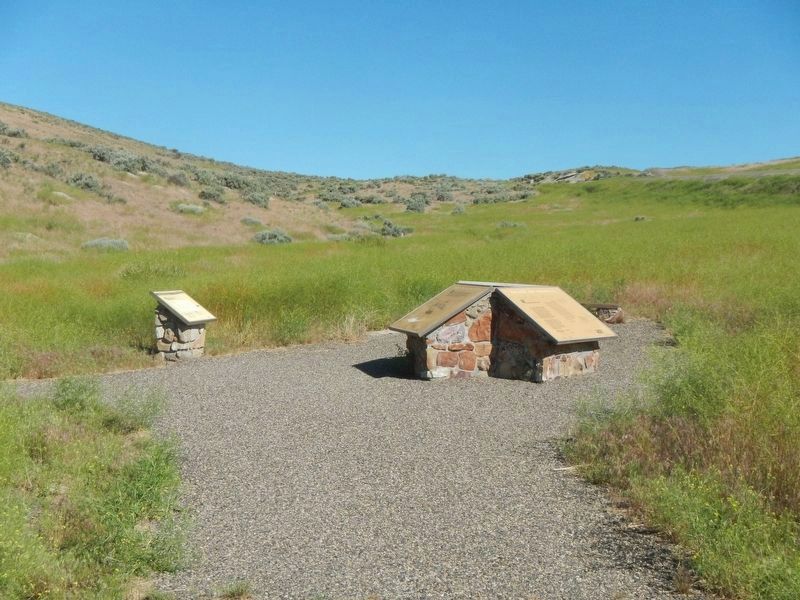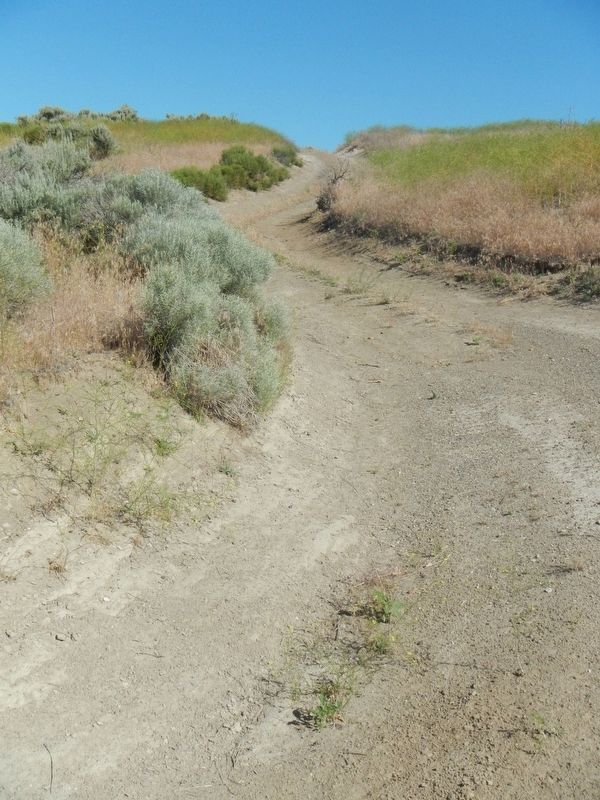Near Vale in Malheur County, Oregon — The American West (Northwest)
Under the Wagon Cover
Day After Day
Hazards and Hardships
By the time the pioneers reached this point in their journey, many supplies had been exhausted or discarded to lighten their load. Many who had depended on getting food at Fort Boise were disappointed, either there were no supplies to be had or they were expensively priced.
Items packed at the beginning of the journey: fiddle and flute sheet iron stove dutch oven kettle water keg table china quilts bed frame chest of drawers clothing and shoes grandfather clock camp lantern guide book chairs needles pins thread rifles and pistols matches knife whetstone ax plow hammer trunk pen and ink Bible doll
Items discarded along the way: sheet iron stove table china bed frame chest of drawers grandfather clock chairs plow trunk
Here is a memorandum of our outfit and eatables: three sacks flour, 100 lbs bacon, 50 lbs sugar, 55 lbs coffee, 7 lbs tea, half bushel of dried apples, bottle pickles, two tin pans, two tea kettles, one dish kettle, one bake kettle, one coffee mill, 6 knives and forks, six tea spoons, three large table spoon, eight tin and iron cups, one candle stick, eight pounds candles, frying pan, tin and wooden pail, keg for water, nine bars soap, five woolen blankets, one large tent, rifle and accoutrement.
... no one should travel this road without medicine . . .Each family should have a box of physicing pills, and a quart of castor oil, a quart of the best rum and a large vial of pepperment essence . . .. Anybody in preparing to come to this country should make up some calico shirts to trade to the Indians in case of necessity. You will have to hire them to pilot you across the rivers.
My husband and I brought our Bible, dictionary, arithmetic, grammar, charts and maps, also our diplomas of graduation.
Although our teams have not got what may be called heavy loads, it appears to be difficult for all to get along. Consequently, we left one of our wagons, two boxes of valuable books, trunks, chairs, etc. worth at least $300.00. This is sad destruction but it cannot be avoided.
A great many had depended on getting provisions here but failed entirely of getting anything except fish -- There is a little sugar for sale here at .75 cents pr pound -- Prospects seem to darken around us ... some families are already entirely out of bread ... -- Cecelia Adams and Parthenia Blank at Fort Boise on the Snake River, September 20, 1852
While the challenges of the countryside varied, the daily tasks remained the same.
Women and girls performed backbreaking camp chores and cared for the little children and the sick. Men and boys did most of the work with wagons and livestock, hunting and fishing when possible, and settling disputes. Bachelor men often had to perform unfamiliar tasks such as cooking, washing, and mending. Children helped their parents, but also found time to play house under the wagon, gather flowers and berries, or ride horses together.
Day after day, week after week, we went through the same routine of breaking camp at day break, yoking the oxen, cooking our meager rations over a fire of sagebrush. Packing up again, coffee pot and camp kettle, washing out scanty wardrobe in the little streams we crossed, striking camp again at sunset, or later if wood and water were scarce. -- Lugarax Stanley Wilson, 1849
We now pursued our journey quietly and even monotonously. Each day the same program, the men gathering up the stock, harnessing the teams to the wagons, the women cooking, washing dishes, packing away their utensils, putting up lunches for the noon hour. -- Sarah J. Cummins, 1845 In respect to womens work the days are all very much the same except when we stop for a day. Then there is washing to be done and light bread to make and all kinds of odd jobs. Some women have very little help about camp being obliged to get wood and water ... make camp fires, unpack at night and pack up in the morning ... -- Helen Carpenter, 1857 When we come to camp, we pitch our tents, spread out blankets and there rest our weary frames. Thus the days and weeks wear away ... -- Sarah Smith, 1838
The pioneers faced many hazards.
Over some they had little control: diseases, drownings, snake bites and livestock stampedes. Traumatic injuries were caused by such events as falling from a moving wagon and being run over or simply twisting an ankle. There were also accidents and deaths involving firearms. Emigrants were forced to travel in extreme weather conditions and sometimes found themselves at the mercy of unscrupulous traders.
Other hardships, perhaps the result of poor judgement or inexperience, were just as dangerous: lost children, prolonged thirst, running out of supplies or the over burdening of an ox. Some travelers discovered too late the consequences of making a wrong decision in choosing an unproven alternate route.
Whatever the origin, each peril had to be overcome.
After experiencing so many hardships you doubtless will think I regret taking the long and tiresome trip and would rather go back than proceed to the
end of my journey. But, no, I have a great desire to see Oregon, and besides, there are many things we meet with ... to compensate us for the hardships and mishaps we encounter. People who do come must not be worried or frightened at tifles, they must put up with storm and cloud as well as calm and sunshine; wade through rivers, climb steep hills, often go hungry, keep cool and good natured always, and possess courage and ingenuity equal to any emergency, and they would be able to endure unto the end. A lazy person should never think of going to Oregon. -- Elizabeth Wood, 1857
... layed by to dry out things which got wet crossing the Snake river. Mr. Kimbles oldest son died of tipus fever ... buried the corpse, proceeded on our journey. -- Elizabeth Dixon Smith, September 1847
Went on till about half past nine and stopped to see another ox die, one hour finished the ox, and we go on somewhat sad not knowing what situation we may be left in at this rate of loss, but try still to say Thy will be done. -- Philip Condit, 1854
Topics. This historical marker is listed in these topic lists: Roads & Vehicles • Settlements & Settlers. A significant historical date for this entry is September 20, 1852.
Location. 43° 54.588′ N, 117° 10.606′ W. Marker is near Vale, Oregon, in Malheur County. Marker is on Lytle Boulevard, on
the left when traveling north. Touch for map. Marker is in this post office area: Vale OR 97918, United States of America. Touch for directions.
Other nearby markers. At least 8 other markers are within 7 miles of this marker, measured as the crow flies. First People of the Land (within shouting distance of this marker); In Search of a Dream (within shouting distance of this marker); Imagine a Day's Journey (within shouting distance of this marker); John D. Henderson (approx. 5.2 miles away); Cutoff Fever (approx. 5.8 miles away); Rinehart's Stone House (approx. 5.8 miles away); Vale Oregon Trail Kiosk (approx. 5.8 miles away); Vale (approx. 6.2 miles away). Touch for a list and map of all markers in Vale.
More about this marker. This marker is located about 1/4 mile south of Captain Keeney Pass and 6 miles southeast of Vale.
Credits. This page was last revised on August 15, 2017. It was originally submitted on August 14, 2017, by Barry Swackhamer of Brentwood, California. This page has been viewed 274 times since then and 21 times this year. Photos: 1, 2, 3, 4, 5. submitted on August 14, 2017, by Barry Swackhamer of Brentwood, California.
